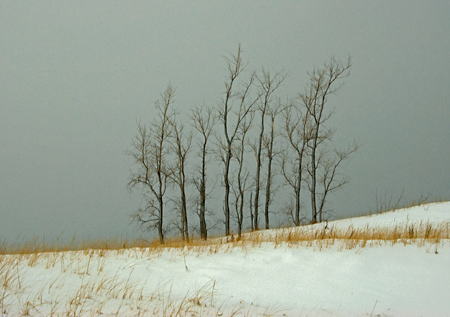After musing for decade or so on how to capture this solitary stand of cottonwoods growing on a ridge in the dunes, the challenge was met through dérive or drifting.

In the past, these cottonwoods had been observed only at a distance from across a wide sand bowl. Trying to snap them had been a futile exercise.
Doing justice to the expanse of the bowl with wide-angle optics, the cottonwoods showed up as tiny sticks in the far distance. Zooming in with telephoto optics, deprived them of any relationship with their terrain.
On a hike through these regions on a wintry day, a snowstorm erupted. Instead of retreating back into the woods, we avoided the punishing winds in the sand bowl by drifting along the back of the ridge enclosing the bowl.
Suddenly, I found myself face to face with my old cottonwood friends.
For map lovers, a Google terrain and corresponding satellite maps show the trail through the bowl and the location of the trees on the ridge.

Today, I am drifting through the snowy streets of NYC, looking for other happy surprises.

Birgit,
I love these muted colors! The green-blue and the orange are complementary in a color theory sense, and balance well because the weaker one has a large area, while the stronger one has interesting detail.
Your composition is also quite balanced, and I was curious to see what would happen if it were unbalanced. I didn’t feel a lot of change unless I went to extremes; it seems your cottonwoods are quite well settled in their place. With severe cropping from right or left I got the results below.
I’m not recommending these versions, just exploring how they work differently, using your walk/drift as a test example for different ways of illustrating it. For example, it seems the cropped versions have a suggestion of direction, namely toward the open space. In the second this is uphill and toward the darker sky, so it feels like heading for a bit of a trial.
I agree that sometimes the most expressive rendition can come from a surprise angle of view. To me that’s the power of the dérive concept. But there are two sides here: the landscape and yourself. Perhaps it was more a difference in you that day that made this feel like a better capturing of something about the cottonwoods?
Steve,
Thank you for this observation …balance well because the weaker one has a large area, while the stronger one has interesting detail.
Of your cropped pictures, the second one, leading uphill, appeals to me better.
Birgit,
Your photo has your unmistakable touch — a sense of something mystical (and maybe magical) just around the corner/over the brow of the hill. And Steve’s cropping, while interesting, pretty much loses that attribute. His second cropped photo seems to maintain the sense of coming onto something just beyond view better than his first crop. But yours is better than either in this regard.
It’s obvious to me how you do catch this sensation with paths through the dunes, but I can’t quite suss out how the sense of something just out of sight, out of reach, can be achieved with such a simple image.
Re: drifting — I’m thinking that returning to the same scene and circling it and poking at it visually is a form of drifting — the scene is intentionally the same, but it isn’t clear — until it is — what will come of the “circling.” A kind of drifting in circles, if you will. That works for me and seems to be working for you as well.
June,
You, too, …drifting in circles,.. looking for ..something mystical (and maybe magical)..?
I don’t know if this has a durned thing to do with it, but it would seem that you tend to favor the transitory. Dunes, tidal flats, ice and glacial valleys and clouds all have, with the valley excepted, a rapid changeability. your trees may be altered in some fashion ere you approach them to your satisfaction.
Jay,
You may have something there. Of Steve’s two crops, the upper one, portraying something more stationary, does not give me pleasure.
Even glacial valleys are sculpted by the storms.
Birgit:
The action of ice at a slower pace. Within the past ten thousand years or so June’s house was covered intermittently with vast floods of glacial melt. My own was buried under some thousands of feet of dirty ice and a large glacial erratic sits primly on a hill top in Maine.